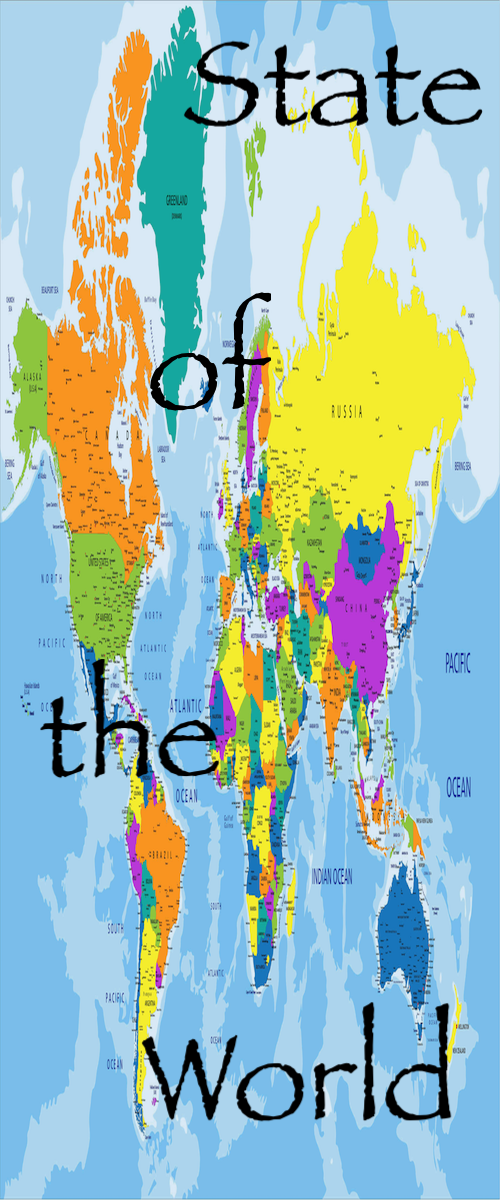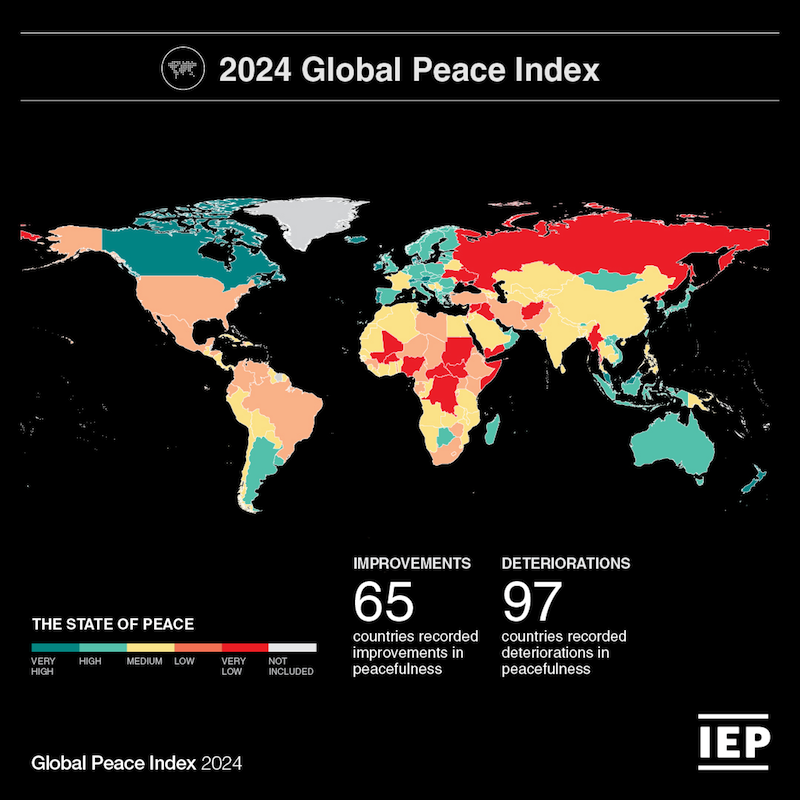That's largely the result of mainstream media, which tends to sensationalize bad situations to make them - if at all possible - appear even worse. When there's a shootout with criminals, the TV news zooms in on the shooting and highlights whatever maiming or killing occurred. Meanwhile, three blocks away, Mrs. Doright has baked an apple pie which her two granddaughters are enjoying, with ice cream on top.
We never get to see the millions of interactions of everyday life that are almost always non-violent. We are fed an endless stream of rapes, murders, crimes, deceptions, wars and pestilences to a point at which, if all one did was read the most sensational news stories, would have one believe that the entire planet is a uniquely dangerous and largely unfriendly place where one must be constantly on guard, carry a weapon for self-defense and have one's head on a proverbial swivel because danger lurks around every corner and in every passing person's being.
Published annually, the 2024 GPI measures peace using a rigorous methodology with no less than 23 different indicators measuring three primary domains:
Ongoing Domestic and International Conflict
All scores for each indicator are normalized on a scale of 1-5, whereby qualitative indicators are banded into five groupings and quantitative ones are scored from 1 to 5, to the third decimal point. It's quite precise, even though the process tends to lean toward a subjective analysis.
In any case, the findings in the June 2024 GPI (published in June, 2024, so there's soon to be an updated version) indicated that the most peaceful - and, by inference, safest - places to live were:
and the least peaceful:
Among the surprises were that Canada was the only country in the Western Hemisphere to rank anywhere near the Top 10, the next being Argentina, all the way down at #47 (of 163). Not that it should dissuade anybody from moving to the United States or anywhere in South America, there are certainly plenty of safe places in both.
Largely rural areas of Bolivia, Peru, Uruguay, Costa Rica and elsewhere on the continent are simply pleasant and easy-going, if not a bit poverty-stricken, by no means the fault of the native populations. Likewise, there are plenty of places in the United States where one can live free from danger other than possibly wildlife in the woods, like rural areas of Kentucky, Tennessee, Texas, the Carolinas, Maine, the Dakotas, and a host of others. America is a vast continent. There's plenty of room to stretch out, and, if you understand well enough the laws and customs, one can live pretty much an unfettered existence. (Ed. Note: IdleGuy.com has its headquarters in rural Tennessee)
The finding that seven of the top 10 most peaceful places were either in Europe proper or part of the EU suggests the authors may have a slight Western European bias. The placing of Russia as the seventh-worst country on the planet - right behind Ukraine and the Congo - was also indicative of some possible political bias. Russia is the world's largest country. By that metric alone, most of it would qualify as peaceful. There are stretches of kilometers with nearly no population of which to speak, which, by definition, connotes peace. There are probably people in Russia who don't even know their country is engaged in a military conflict in Ukraine.
It was also surprising to see Israel down near the bottom, identified as a place not very much at peace, though it's likely that what passes for journalism in the Western world is probably under-reporting the levels of violence, disruptions to daily life, acts of terror, and general malaise that is gripping the country. After all, it's been at war for nearly two years now and continues to expand its operations, north to Syria, east to Yemen and eventually targeting Iran, which, incidentally, tallied at #133, just a touch less peaceful than the United States (132) and Brazil (131). Iran did move up - towards more peaceful - 10 spots from 2023 while the USA dropped two places.
The authors of the report made some key findings, among them, that peacefulness deteriorated by 0.56% from the previous year, globally, and 2024 was the fifth consecutive year of deterioration. Also, they discovered, paradoxically, that their Militarization domain improved by 3.4% while Ongoing Conflict deteriorated by an alarming 19%. Deaths from internal conflict (civil war, civil unrest) increased by more than 475% since they began the annual survey 17 years ago.
Also highlighted in the report are sections on the economic impact of violence and trends in war in the 21st century.
While the report covers the entire planet at a nation-centric level, it does attempt to drill down into detail in specific instances. For instance, the section detailing the improvement in El Salvador (ranked 107, +21) cites the government crackdown on gang-related violence as the number one driver for increased peacefulness. On the ground reporting elsewhere verifies their findings.
On the other end of the scale, Israel's fall to #155 in the rankings (-11) is an evolving process, the country's rank having fallen for three consecutive years, and accelerated this year with significant deteriorations recorded in deaths from external conflict, deaths from internal conflict, and poorer relations with neighboring nations.
In the larger scheme, peace, safety, security, and enjoyment of life's pleasures can still be achieved, though, judging by the tone of the 2024 GPI report, achieving a high level of human satisfaction and peaceful co-existence is a commodity becoming more scarce and one worth pursuing. The 2024 GPI is a good place to begin the journey.
 Most of the time, when people are weighing things up, the focus is on the negative, as in world affairs, crimes, wars, famines, natural disasters, economic disruptions, and general violence get the headlines while the vast majority of the rest of the world is - for the better part - peaceful, if not downright tranquil.
Most of the time, when people are weighing things up, the focus is on the negative, as in world affairs, crimes, wars, famines, natural disasters, economic disruptions, and general violence get the headlines while the vast majority of the rest of the world is - for the better part - peaceful, if not downright tranquil.
 The fact of the matter is that most of the world is at peace, if not downright tranquil. Given that rural areas - farms and hinterlands - are more oriented toward relaxed mutual respect and minding one's own business than cities, idleguy.com decided to take a more macro view, to determine which countries are regarded as safest and which are more or less dangerous places. What we found was an entire organization dedicated to measuring such things, at the Vision of Humanity website and the painstakingly-precise Institute for Economics and Peace's Global Peace Index (GPI). [PDF]
The fact of the matter is that most of the world is at peace, if not downright tranquil. Given that rural areas - farms and hinterlands - are more oriented toward relaxed mutual respect and minding one's own business than cities, idleguy.com decided to take a more macro view, to determine which countries are regarded as safest and which are more or less dangerous places. What we found was an entire organization dedicated to measuring such things, at the Vision of Humanity website and the painstakingly-precise Institute for Economics and Peace's Global Peace Index (GPI). [PDF]
Societal Safety and Security, and,
Militarism
|
|||
| search engine by freefind |
Your ad could be in the next issue of idleguy.com for as little as $6 per month. Contact Fearless Rick using the form on page 12 for more information.
Don't miss the idleguy.com / dtmagazine.com INVENTORY SALE of vintage magazines, going on now!